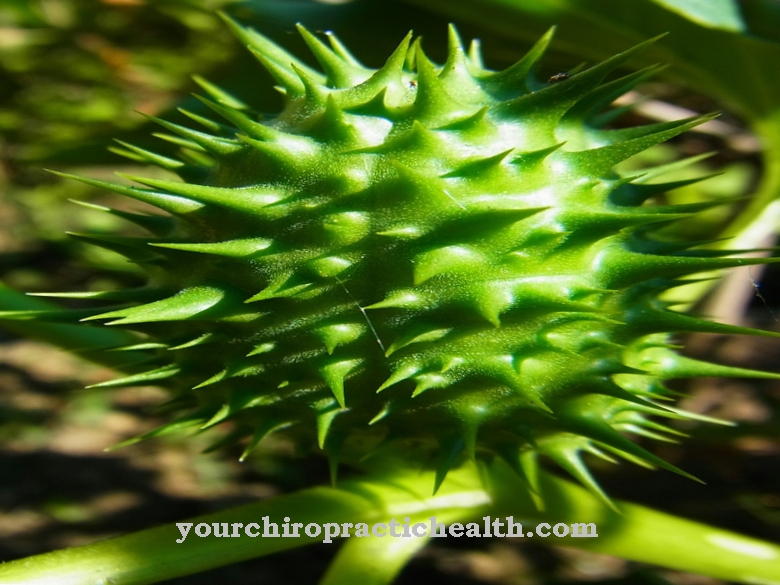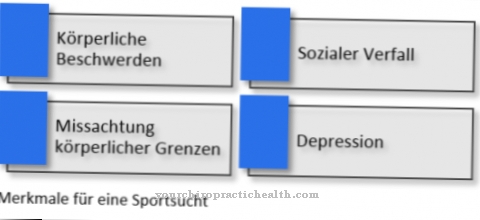Heat stroke can result from exposure to sunlight or other heat sources. The transition from overheating to heat stroke is initially fluid, but it is easy to recognize from the symptoms that are quite clear. Severe heat stroke is a serious medical emergency that requires immediate therapeutic intervention in the form of lowering body temperature. With simple means you can treat heat stroke.
What do you recognize heat stroke
The general well-being is greatly reduced by the build-up of heat in the organism during heat stroke. The body's heat regulation mechanisms, especially sweating through the skin, are overloaded over time as a result of the constant exposure to heat from solar radiation. The core body temperature, which is normally 37 degrees Celsius, can rise to over 41 Celsius in the event of a heat stroke.
The most important diagnostic identifier is therefore fever. The high body temperature can irreversibly damage the brain and other internal organs. Typical symptoms are red, dry and hot skin, vomiting, dizziness, headache, possibly accelerated breathing or loss of consciousness with seizures and hallucinations.
5 tips to cool the heated body
The most important measure in the event of heat stroke is to lower the core body temperature. This is done by applying cooling compresses to the extremities or by carefully spraying cold to lukewarm water. Fever-lowering drugs, such as paracetamol or acetylsalicylic acid, as they should be in every medicine cabinet, are also helpful.
In the event of unconsciousness or symptoms of shock, medical advice must be sought in any case. If seizures occur, so-called benzodiazepines are usually administered. Those affected should go to the shade immediately and often feel better when the upper body is slightly elevated. Clear, non-carbonated water or diluted apple spritzer should only be served if you are conscious. The drinks should not be too cold, however, but lukewarm.
1. Move to a shady and cool place
Heat stroke is often confused with sunstroke, but is far more dangerous from a medical point of view. All therapeutic measures should only begin when the person affected has moved to a shady and cool place either on their own or with the help of third parties. Ideally, all further measures should be carried out in closed, cool rooms.
If this is not possible, the first aid can also take place outside in a shady place, but in any case with the exclusion of further sunlight. The beginning of the shock symptoms can be recognized by the dry and hot skin, associated with a high resting heart rate and, at the same time, low blood pressure. The patient should be transported to the nearest hospital for further intensive medical monitoring.
2. Drink enough
By definition, heat stroke occurs when a fever of 40 degrees Celsius or more is measured in the rectum or under the armpit. The body's own regulatory mechanisms try to lower body temperature by releasing fluid through the skin, i.e. sweating. If too little fluid is supplied, the increased heat production, especially during physically demanding work, can no longer be compensated.
A sufficient supply of liquid in the form of not too cold, electrolyte-rich drinks, for example mineral water or juice spritzers, is therefore essential. If you stay in the sun for a long time, you should continuously drink small sips of liquid.
3. Wear loose clothing
Unfavorable, i.e. non-breathable clothing can also promote heat build-up in the body, so that the symptoms of heat stroke appear even earlier. In any case, loose clothing is an advantage if heat stroke is to be avoided.
As far as possible, all exposed skin areas should be covered in order not to additionally expose yourself to the risk of sunburn. Branded goods made of pure, thinly woven, white-dyed cotton have proven themselves as loose clothing, because these are particularly breathable and skin-friendly.
4. Alternating showers
With any type of heat stroke, it is important to cool the body carefully. Alternating showers are therefore well suited for the therapy of lighter heat strokes, but also for prophylaxis if they are carried out regularly in the morning and evening. The change from lukewarm to cold and warm to hot water not only trains the immune system, but also ensures that the heat can be better transported out of the body.
5. Care creams for the skin
Skin care creams are not suitable for the direct treatment of heat stroke, but should be used to regenerate the skin after the first symptoms have subsided. Skin care creams based on fat are not suitable, however, because the stressed skin needs above all moisture in the form of lotions or gels with a high water content and soothing substances.
When should you consult a doctor?
Medical help is always required in the event of heat stroke if the symptoms do not improve quickly or even worsen despite the cooling measures. Even if the symptoms are severe, if there is a high fever or if patients cannot tolerate large amounts of water due to previous illnesses, medical advice must be obtained. This also applies to all forms of shock symptoms with circulatory failure or impaired consciousness.
What to do to prevent heat stroke
In order to prevent the dangerous build-up of heat in the body, breathable clothing should always be worn when outside temperatures are high and strenuous physical activity should be avoided. Make sure you drink enough fluids as well as the constant cooling of arms and legs by pouring cold water at high outside temperatures. Sports activities should never be carried out in the blazing midday heat, but rather in the morning or evening hours.
Enjoy the sun in moderation
The development of heat stroke does not, as is often assumed, depend on the skin type. The first symptoms of heat stroke are often only noticed after hours of exposure to the sun. In general, strenuous activities with high outside temperatures or increased solar radiation should be avoided. Knowing about the dangers of exposure to the sun for too long and to prevent heat stroke, sun exposure should only be enjoyed in moderation, even with UV skin protection.

















.jpg)



.jpg)

.jpg)




